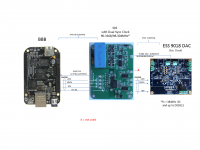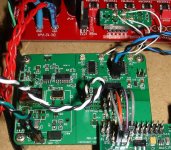Hi Acko,
Please excuse my ignorance! I do not see and ground connection to/from S03.
Sorry, they are not wiring diagrams and gnd/power connections not shown. Just to illustrate various operating modes
Hi Acko,
Please excuse my ignorance! I do not see and ground connection to/from S03.
They're simple logical diagrams so the ground connections are inferred. In a physical implementation there will be a ground connection for each of the data paths shown, typically via the ufl connectors.
Ray
BBB- ESS DAC in Overdrive Mode
From previous posts, 45.xx/49.xxMHz clocks are enough for perfect synchronous re-clocking up to 384KHz Fs and this applies to ESS DACs also.
So why have some designs used 98.xxx/90.xxMhz clocks even though the re-clocking outcome remains unchanged?:
1. ESS DAC also connected to spdif direct. This is ASync operation and requires ~80Mhz clocks to handle up to 192KHz Fs. So 98.xxx/90.xxx handles this nicely. (only one clock needed)
2. Higher Fs beyond 384KHz?
3. The jitter reduction mechanism in ESS DACs works better at higher clock frequencies, obviously computations can be completed faster.
Assuming we ignore #1 and #2 or spdif not needed then we are left with just the prospect of better performance with this overdrive mode.
But there are issues to consider:
1. phase noise performance for typical 98.x/90.xx oscillators are generally not as good as the 45.xx/49.xx types from most crystal manufacturers. So whilst jitter reduction in the DAC yields higher apparent resolution this can be negated by the phase noise of the clocks- some reports have already indicated this effect, like sounding a bit bright, "musical", etc.
2. board, components and power supplies are stressed more at higher frequencies, plus EMI
May have to consider more expensive OCXO types and premium grade board material/parts if this type of operation is desired.
Full Sync capability, I2S and DSD
From previous posts, 45.xx/49.xxMHz clocks are enough for perfect synchronous re-clocking up to 384KHz Fs and this applies to ESS DACs also.
So why have some designs used 98.xxx/90.xxMhz clocks even though the re-clocking outcome remains unchanged?:
1. ESS DAC also connected to spdif direct. This is ASync operation and requires ~80Mhz clocks to handle up to 192KHz Fs. So 98.xxx/90.xxx handles this nicely. (only one clock needed)
2. Higher Fs beyond 384KHz?
3. The jitter reduction mechanism in ESS DACs works better at higher clock frequencies, obviously computations can be completed faster.
Assuming we ignore #1 and #2 or spdif not needed then we are left with just the prospect of better performance with this overdrive mode.
But there are issues to consider:
1. phase noise performance for typical 98.x/90.xx oscillators are generally not as good as the 45.xx/49.xx types from most crystal manufacturers. So whilst jitter reduction in the DAC yields higher apparent resolution this can be negated by the phase noise of the clocks- some reports have already indicated this effect, like sounding a bit bright, "musical", etc.
2. board, components and power supplies are stressed more at higher frequencies, plus EMI
May have to consider more expensive OCXO types and premium grade board material/parts if this type of operation is desired.
Attachments
Last edited:
Cheers Guys!
Exciting..! Looking forward for my fully essembled S03. I will first test it with BBB /DDDAC combo, not too long now! 🙂
Exciting..! Looking forward for my fully essembled S03. I will first test it with BBB /DDDAC combo, not too long now! 🙂
Hi Palmito,I'm using the raspberry pi and multi-purposing the S03 (which BTW, is a very flexible design, thanks Acko) with Doede's dac.....
Acko's support, as always, is outstanding... 😉
In reference to your photo as per attached, I see the little PBC board used as input into DDDAC's I2S. Would you please direct me to where to source one? Anyone? 😕
Many thanks in advance.
Best,
Chanh
Attachments
Hi Palmito,
In reference to your photo as per attached, I see the little PBC board used as input into DDDAC's I2S. Would you please direct me to where to source one? Anyone? 😕
Many thanks in advance.
Best,
Chanh
That PCB(BIII adaptor) is from Ian's FIFO GB. I have one and used it on my DAC project as well. Many ppl don't release how useful it is. Its so useful I think I gonna buy a few when the next GB is on.
2nd picture
http://www.diyaudio.com/forums/grou...-pdif-fifo-kit-group-buy-136.html#post3662746
EDEL network audio Media Renderer
This is a very interesting product:
Network Audio Renderer | ABC PCB
Hard embedded system with no power sequencing or shutdown issues and no messing around with Linux. I2S and DSD with full flexibilty.
The S03 module matches well for full synchronous re-clocking, just replace the BBB as shown in the previous post with this EDEL NMR and you are away!
This is a very interesting product:
Network Audio Renderer | ABC PCB
Hard embedded system with no power sequencing or shutdown issues and no messing around with Linux. I2S and DSD with full flexibilty.
The S03 module matches well for full synchronous re-clocking, just replace the BBB as shown in the previous post with this EDEL NMR and you are away!
Thank You flowerpot. PM sent to Iancanada.
Interesting...! Looks like a very simple diy front end, only if it sounds equal or better than MPD using BBB? I've spent thousands of dollars getting my dual pc setup Optimised, Jplay in hibernate mode,..., and at the end found out by experiment that the little Raspberry Pi and BBB sound way better via I2S when using MPD. 😕This is a very interesting product:
Network Audio Renderer | ABC PCB
I may get one to try out. Swiss made..., I'm sold! 😀
This is a very interesting product:
Network Audio Renderer | ABC PCB
Hard embedded system with no power sequencing or shutdown issues and no messing around with Linux. I2S and DSD with full flexibilty.
The S03 module matches well for full synchronous re-clocking, just replace the BBB as shown in the previous post with this EDEL NMR and you are away!
Yes, this one looks really REALLY interesting.. But the question is - who sells them? Seems to be OEM-sales through the manufacturer?
Yes, this one looks really REALLY interesting.. But the question is - who sells them? Seems to be OEM-sales through the manufacturer?
I've queried availability and pricing via the website. I will report back when I know more.
Ray
Cool! May be a groupbuy?I've queried availability and pricing via the website. I will report back when I know more.
Ray
This is a very interesting product:
Network Audio Renderer | ABC PCB
Looks like a big step forward !!!
Very interested in pricing
Network Audio Renderer | ABC PCB
Looks like a big step forward !!!
Very interested in pricing
the little Raspberry Pi and BBB sound way better via I2S when using MPD
I imagine there is a reasonable chance that the code embedded in the EDEL device is written in Linux, utilising MPD?
Ray
Interesting...! Looks like a very simple diy front end, only if it sounds equal or better than MPD using BBB? I've spent thousands of dollars getting my dual pc setup Optimised, Jplay in hibernate mode,..., and at the end found out by experiment that the little Raspberry Pi and BBB sound way better via I2S when using MPD.... 😀
Many thanks for your efforts and feedback!
Just curious- after having checked out your "LauchPad"😛 with music apparently direct from a USB stick attached to the BBB whether there is any difference if streamed over a network? i.e. BBB as a network renderer
Last edited:
I've queried availability and pricing via the website. I will report back when I know more.
Ray
I'm interested as well
I've queried availability and pricing via the website. I will report back when I know more.
Ray
Yes, please let us know when you hear something from them - this is most certainly interesting!
Robert
Many thanks for your efforts and feedback!
Just curious- after having checked out your "LauchPad"😛 with music apparently direct from a USB stick attached to the BBB whether there is any difference if streamed over a network? i.e. BBB as a network renderer
Haha..! Thanks for the compliment. Actual fact, I received lots of criticisms with this built and the direction I took in diy. Many ended up zipped up after I held many gtg(s) shootout this DAC against $25k+ high-end SACD player(s) and DAC(s), including Accuphase, PS Audio DSD,..., Oppo 95 modded by JLTi.
In regards to your curiosity, I found SD/Flash Drive/SSD sounded better than usb spin HDD, and again better than NAS without isolated switch with linear ps. My NAS is now connecting into a switch where each is power by a linear ps and upstream is a 5kVa isolation balance transformer. Despite that Usb flash drive and SD still sound inconveniently better! 😀
Haha..! Thanks for the compliment. Actual fact, I received lots of criticisms with this built and the direction I took in diy. Many ended up zipped up after I held many gtg(s) shootout this DAC against $25k+ high-end SACD player(s) and DAC(s), including Accuphase, PS Audio DSD,..., Oppo 95 modded by JLTi.
In regards to your curiosity, I found SD/Flash Drive/SSD sounded better than usb spin HDD, and again better than NAS without isolated switch with linear ps. My NAS is now connecting into a switch where each is power by a linear ps and upstream is a 5kVa isolation balance transformer. Despite that Usb flash drive and SD still sound inconveniently better! 😀
You are actually being richly rewarded

Thanks to your pics and reports we can see clearly now that the underpinnings play a very important part!
Don't ditch the RPi or BBB yet as they can locally serve up music but the EDEL NMR and similar lifestyle products depend on network feed over many layers.
Again, going back to steadying the stream with NAS feed you may want to try inserting the fabulous Ian's FIFO (if you have one) and see how it goes. This should swamp out all perturbances and regenerate clean re-clocked signals.
Last edited:
...... the EDEL NMR and similar lifestyle products depend on network feed over many layers.
Again, going back to steadying the stream with NAS feed you may want to try inserting the fabulous Ian's FIFO (if you have one) and see how it goes. This should swamp out all perturbances and regenerate clean re-clocked signals.
There appears to be some sort of FIFO action in the EDEL MNR looking at the datasheet, so just as well
Is there anything similar with RPi and BBB? I cannot seem to find any concept diagrams or operational details for these 'open source' Linux boxes
- Home
- Group Buys
- Amanero Isolator/Reclocker GB

